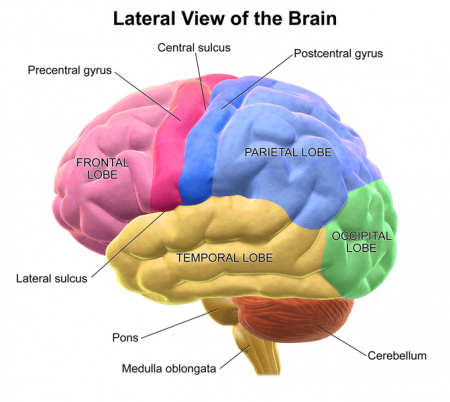

It receives and sorts sensory information then directs it to the appropriate area of the the cerebrum for further processing. Serves as the "switchboard" operator of the brain. Thalamus Forms the major portion of the diencephalon (80%). A deep groove that separates the parietal lobes of the cerebrum from the cerebellum. Septum pellucidum thin medial partition that separates the lateral ventricles Transverse cerebral fissure Posterior view of brain.

Longitudinal fissure Deep groove that separates the left and right hemispheres of the brain. Optic tract The part of the brain between the optic chiasm and the lateral geniculate body Parieto-occipital sulcus Separates the occipital lobe from the parietal lobe and the temporal lobe. The optic chiasm is located at the bottom of the brain immediately below the hypothalamus. Optic chiasma The part of the brain where the optic nerves (CN II) partially cross. Olfactory bulb one of two enlargements at the terminus of the olfactory nerve at the base of the brain just above the nasal cavities Olfactory tract the path along which the olfactory receptors send their electrical messages to the brain. Intermediate mass of the thalamus Lateral sulcus Separates the temporal lobe from the frontal lobe and parietal lobes. White matter Superior colliculus Inferior colliculus sound info sent here, involved in the startle reflex and helps keep eyes fixed on point while head is turned (vestibulo-ocular reflex) Infundibulum A stalk that attaches the pituitary gland to the hypothalamus. Fornix a bundle of axons that originates in the hippocampal formation, loops around the thalamus, and terminates in the diencephalon Gray matter Brain and spinal cord tissue that appears gray with the naked eye consists mainly of neuronal cell bodies (nuclei) and lacks myelinated axons. Choroid plexus A highly vascular portion of the lining of the ventricles that secretes cerebrospinal fluid. Central sulcus Separates the frontal from the parietal lobe. Cerebral Cortex Cerebellum (posterior view) Contains the centers for controlling muscle tone, muscle coordination and balance. Cerebellum Contains the centers for controlling muscle tone, muscle coordination and balance. Occipital lobe (lateral view) Responsible for interpreting visual information.


 0 kommentar(er)
0 kommentar(er)
